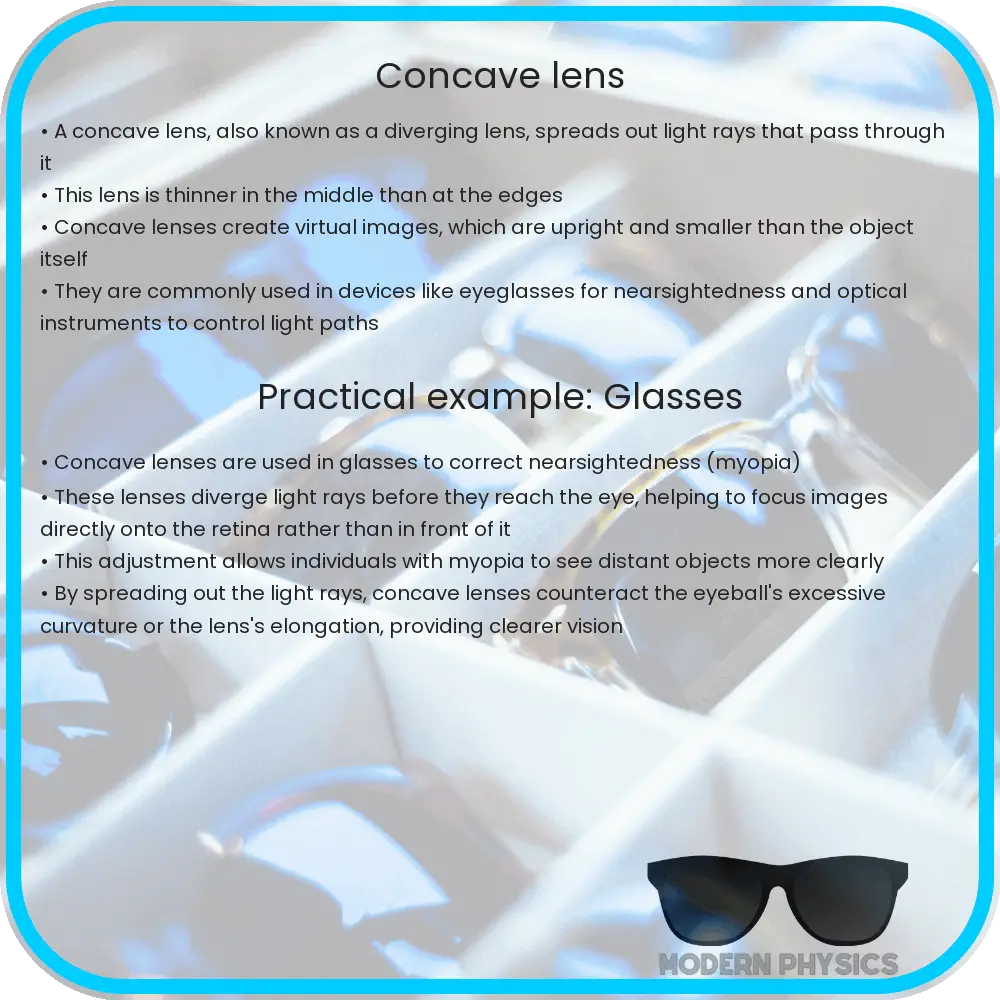Explore the principles and diverse applications of concave lenses in optics, from vision correction to advanced astronomy and photography.

Understanding Concave Lenses
A concave lens, often termed a diverging lens due to its ability to spread out light rays, is a vital component in various optical devices. This lens is thinner at its center than at its edges and is commonly used to correct specific vision problems and in several optical instruments. The principles of light behavior through concave lenses are foundational in understanding their diverse applications.
Principles of Light Refraction in Concave Lenses
Concave lenses operate on the principle of refraction, a phenomenon where light changes direction as it passes through mediums of different densities. When light rays enter a concave lens, they are diverged or spread out. This divergence occurs because the light rays bend away from the lens’ normal line, a perpendicular drawn at the point of contact on the lens surface. The degree of bending is determined by the lens material’s refractive index, a measure of how much it can bend light.
Image Formation by Concave Lenses
The image formed by a concave lens is always virtual, meaning it cannot be projected on a screen as it appears to be located on the same side of the lens as the light source. This image is also upright and smaller than the object. The location and size of the image depend on the object’s position relative to the lens. Mathematically, this relationship is described by the lens formula: \(\frac{1}{f} = \frac{1}{v} – \frac{1}{u}\), where \(f\) is the focal length, \(v\) is the image distance, and \(u\) is the object distance.
Common Uses of Concave Lenses
Concave lenses have a range of applications owing to their unique properties. They are extensively used in eyeglasses for correcting myopia or nearsightedness. In this condition, the eye focuses light in front of the retina, and a concave lens helps in diverging the light rays, enabling them to focus on the retina correctly. Additionally, they are used in telescopes, camera viewfinders, and binoculars to adjust the focal length and improve image quality. These lenses also find their use in laser systems to manipulate beam shape and direction.
Understanding the principles and applications of concave lenses provides insight into their significant role in modern optics. In the next section, we will delve deeper into the specific applications of concave lenses and explore their impact in various fields.
Detailed Applications of Concave Lenses
Concave lenses are not just limited to vision correction or simple optical devices; their applications extend to more advanced areas. For instance, in the field of photography, concave lenses are used to reduce chromatic aberration, a type of distortion where a lens fails to focus all colors to the same convergence point. In combination with convex lenses, they help in producing clearer and more accurate images.
In astronomy, concave lenses are crucial components in telescopes, specifically refracting telescopes. They assist in extending the focal length, allowing for the observation of distant celestial objects with greater clarity. This extended focal length also reduces the eyepiece’s magnification, making it easier to view larger sections of the night sky.
Moreover, in the field of laser technology, concave lenses are employed to control and shape laser beams. They are used to expand laser beams before they are focused, ensuring a more precise and controlled application of the laser, which is critical in delicate operations like laser eye surgery or precision cutting in manufacturing.
Technological and Educational Impact
The technological impact of concave lenses is significant. They are integral in developing various optical instruments and devices, contributing substantially to the fields of medicine, astronomy, and manufacturing. Furthermore, concave lenses are essential tools in educational settings, helping students understand fundamental optics principles. Their simplicity and clear demonstration of light behavior make them indispensable in physics classrooms.
Conclusion
Concave lenses are more than just simple glass pieces; they are pivotal in the advancement of optical technology and have a wide array of practical applications. From correcting vision impairments to aiding in the exploration of the universe, their role cannot be overstated. The understanding of concave lenses’ principles and applications is not only essential for those in the field of optics but also for anyone interested in the science of light and vision. As technology continues to evolve, the significance of concave lenses is likely to grow, further highlighting their importance in both our daily lives and in scientific exploration.
